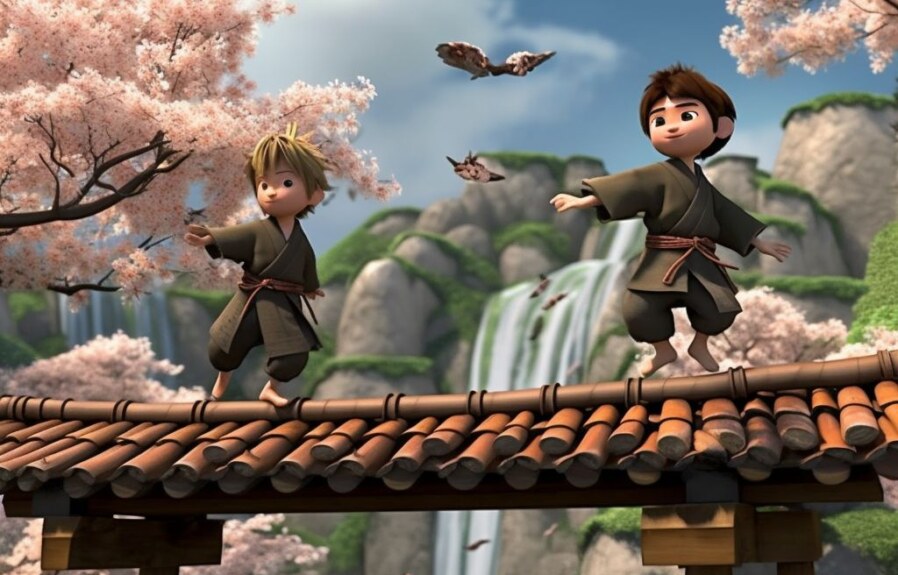Ninjas have always fascinated people with their skills and stealth. The mystique surrounding their ways and techniques have made them a subject of envy and awe. While the idea of becoming a ninja may seem far-fetched to many, the truth is that anyone can learn and practice the basics of this ancient art form. In this article, we delve into the world of ninjutsu and present a step-by-step guide on how to become a ninja, highlighting the key elements and principles required to master this craft. Whether you’re a martial arts enthusiast or just someone looking to pick up a new skill, this article will provide you with a comprehensive insight into the world of ninjutsu and equip you with the tools necessary to become a skilled ninja.
1. What is a Ninja? Understanding the Art of Ninjitsu
Ninjitsu is a Japanese martial art that originated during the feudal era. A trained ninja is skilled at espionage, deception, and guerrilla warfare. They rely on flexibility, speed, and cunning more than physical strength. The word “ninja” means “perseverance” and “endurance”. While the Ninjitsu art was not respected by the samurai who were the ruling class at that time, it plays a crucial role in Japanese history. Today, the art of Ninjitsu is recognized worldwide, and many people have developed interest in learning the art.
The art of Ninjitsu involves a great deal of physical and mental training, including meditation, breathing exercises, and physical exercises. The physical training includes, but is not limited to, punches, kicks, throws, and grappling techniques. In addition, Ninjas learn to use a variety of weapons such as shuriken, kunai, and the Ninjato (the ninja sword). The training is typically performed in a dojo (training hall), where Ninjas learn to channel their energy and control their body movements.
The art of Ninjitsu is not only a martial art but also a way of life. Ninjas live by a strict code of morals and ethics. It is not just a technique for fighting but also a means of achieving inner peace and harmony. There are many benefits to learning Ninjitsu beyond just self-defense. It can help to relieve stress, improve flexibility, and increase self-awareness. Anyone can learn Ninjitsu, regardless of age or physical ability. It’s an art that requires discipline and dedication, but the rewards are endless.
2. Physical Training: Conditioning Your Body like a Stealthy Assassin
One of the most important factors in becoming a successful assassin is having a highly conditioned body that is capable of handling intense physical activities. A seemingly effortless climb over a high wall, a swift run over long distances, or being able to fight off an opponent- these are all essential skills for every assassin. If you want to be as stealthy and lethal as possible, you will need to condition your physical body to its full potential.
To start your physical training, focus on developing your endurance by incorporating aerobic activities such as jogging, cycling, or swimming. These activities can help you build stamina, allowing you to run for longer periods of time and making it easier to escape or pursue a target. It is important to build your cardio foundation before you move onto more rigorous activities.
Next, focus on developing strength, power and speed. This can be done through activities such as weightlifting, plyometrics, and calisthenics. These activities can help develop your core strength, speed, and agility, along with helping you build lean muscle mass that will help you perform your tasks efficiently. To further hone your skills, you can also learn specific martial arts disciplines. Krav Maga, Jiu-Jitsu, and Muay Thai are a few popular disciplines that can be especially beneficial for an assassin.
Investing time and effort into conditioning your body like an assassin will not only make you more successful in your missions but also help you build a healthy and strong body that can withstand the physical demands of life. Remember, the key to success is consistency and discipline in your training regime, along with maintaining a healthy and balanced diet.
3. Mental Training: Developing Focus and Discipline
As important as physical training is for athletes, the mind is just as crucial in sports. That’s why mental training is essential in developing focus and discipline. With mental training, athletes can improve their concentration, boost their confidence, and overcome performance anxiety.
To develop focus, athletes need to practice mindfulness through techniques such as meditation or deep breathing exercises. Mindfulness helps athletes stay present in the moment and keep their attention on their performance rather than outside distractions. Another technique that can develop focus is visualization. By picturing themselves excelling, athletes can create a clear goal for themselves and help their mind hone in on what they need to accomplish.
Discipline is equally important in sports and mental training can help athletes develop it. Creating a routine that includes proper rest, nutrition, and training is essential in building discipline. Setting achievable goals and consistently adhering to them teaches discipline and strengthens mental toughness. Additionally, daily affirmations and positive self-talk can help athletes stay motivated and disciplined, even when they face challenges. By incorporating these techniques into their mental training, athletes can improve their focus and discipline and achieve their full potential in sports.
- Mindfulness techniques: Meditation, deep breathing exercises.
- Visualization: Picturing themselves excelling in their sport.
- Creating routines: Proper rest, nutrition, and training.
- Setting achievable goals and consistently adhering to them.
- Daily affirmations and positive self-talk.
By incorporating these techniques into their mental training, athletes can improve their focus and discipline and achieve their full potential in sports.
4. Mastery of Weapons: Learning to Wield Shurikens, Katana and More
One of the most exciting aspects of martial arts is the opportunity to learn how to wield a variety of weapons. Depending on the style of martial arts you study, you may have the opportunity to learn how to use weapons like shurikens, katana, nunchucks, and more. Of course, mastering these weapons takes time and practice, but the end result can be truly impressive.
One of the keys to mastering martial arts weapons is to start slowly and learn the basics. For example, before you start throwing shurikens, you’ll need to learn how to hold them correctly and throw them with precision. Similarly, before you start swinging a katana, you’ll need to learn the proper way to hold the weapon and execute basic strikes.
In addition to learning the basics, master martial artists also spend time perfecting their technique and honing their instincts. This often involves sparring with other students, practicing kata, and visualizing different scenarios in which they might use their weapons. With time, patience, and dedication, anyone can learn to wield martial arts weapons effectively and with confidence.
5. Stealth Techniques: Moving Like a Shadow to Avoid Detection
Moving with stealth is a key skill for anyone who needs to stay undetected in sensitive, dangerous or spy scenarios. There are several techniques that experts use to move like a shadow and stay hidden. Here are some of them:
- Foot placement: When moving silently, experts place their feet carefully, avoiding spots where gravel or twigs could break and make a noise. They also avoid stepping on hard surfaces that can create echoes.
- Slow and steady: Moving too quickly can create a lot of noise. Skilled practitioners maintain a slow and steady pace, taking smaller steps and keeping their balance over their feet.
- Controlled breathing: Learning to control your breathing is another important skill. Gentle, steady breathing helps to keep your heartbeat and body movements slow and steady. It also reduces the likelihood of panting and blowing out air, causing noise.
These techniques require practice and patience. They take time to master, but with practice, you can become a shadowy figure that moves silently, unheard and unseen. Remember that the key to success is not only in learning the techniques but also in staying calm, focused and having a clear objective in mind. By mastering these techniques, you will not only become more confident in your abilities but also increase your chances of avoiding detection in sensitive or dangerous scenarios.
6. Applying Ninja Principles to Daily Life: Becoming More Resourceful and Resilient
Becoming more resourceful and resilient in daily life is an essential skill that can be developed through practicing the principles of a ninja. Here are some ways to implement these principles:
- Adaptability: Be flexible and open to changing circumstances. Don’t resist change, but embrace it.
- Focus: Concentrate on your goals and stay committed to achieving them.
- Patience: Be patient and persistent. Success often takes time and effort.
- Perseverance: Keep moving forward, even in the face of obstacles and setbacks.
- Resilience: Bounce back quickly from failure or disappointment.
By developing these principles, you’ll become more self-reliant, creative, and innovative in your approach to everyday problems. You’ll also learn to adapt and thrive in challenging situations. Keep in mind that becoming more resourceful and resilient is a continuous process that requires practice, patience, and persistence. So, persevere and apply these principles consistently to achieve your goals and overcome any obstacles that come your way.
7. Joining the Ninja Community: Finding Like-Minded Practitioners and Resources to Support Your Journey
If you’re serious about your ninja journey, there’s no better way to stay on track than by joining the ninja community. There are communities online and offline that can offer support, resources, and mentorship to help you reach your goals.
To find like-minded ninja practitioners, start by exploring online forums and social media groups. Look for groups focused on ninja training, parkour, martial arts, and similar disciplines. Join the conversations, share your progress, and ask questions. You’re likely to find experienced practitioners who can offer advice and encouragement, as well as others who are just starting out and can relate to your struggles.
You can also look for local ninja communities in your area. Check with your local gym, community center, or sports club to see if they offer ninja training classes or know of any groups that meet regularly. Joining a local group can be a great way to connect with others who share your passion and to access specialized equipment and training opportunities. And, meeting in person can provide an extra level of accountability and motivation to stick with your training.
People Also Ask:
What is a Ninja?
A ninja is a person who practices the art of ninjutsu, a Japanese martial art that emphasizes stealth, agility, and combat skills.
What are the qualities of a Ninja?
The qualities of a ninja include physical agility, mental strength, determination, discipline, and the ability to blend in with their surroundings.
What skills do you need to be a Ninja?
The skills you need to be a ninja include hand-to-hand combat, weapons proficiency, stealth, agility, and the ability to adapt to any situation.
Do Ninjas still exist?
In modern times, the concept of a ninja has transcended its historical origins and has become a part of popular culture. However, there are still people who practice ninjutsu as a martial art form.
How long does it take to become a Ninja?
Becoming a skilled ninja requires years of training and dedication. Some experts say that it can take up to a decade or more of daily training to master ninjutsu.
Conclusion:
Being a ninja requires a combination of physical and mental skills developed through years of practice and dedication. While becoming a ninja may not be feasible for everyone, the principles of ninjutsu—such as discipline, determination, and adaptability—can be applied to any aspect of life to achieve success.



